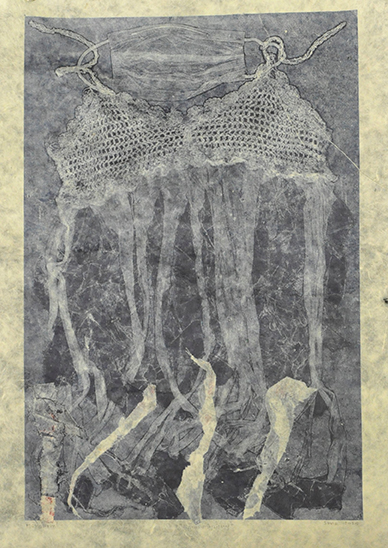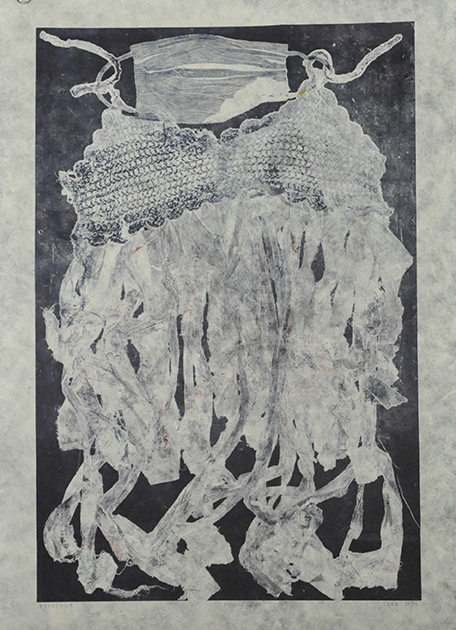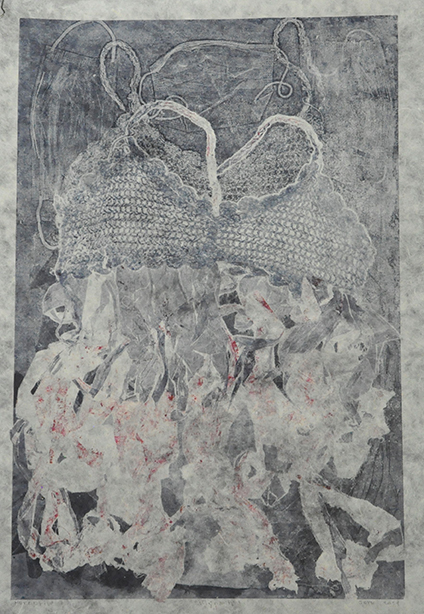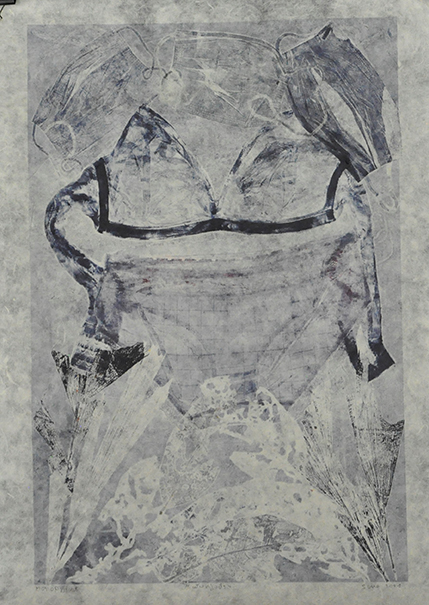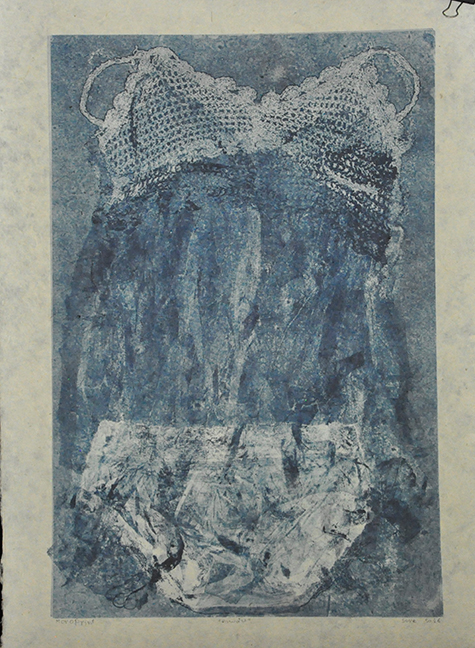ສອນ ເກີດທີ່ແຂວງຫຼວງພະບາງ ຜູ້ທີ່ມີພໍ່ແມ່ເຮັດອາຊີບເປັນຊາວນາ. ພາຍຫຼັງຈາກທີ່ຮຽນຈົບຊັ້ນມັດທະຍົມປາຍ, ນາງໄດ້ເຂົ້າສຶກສາຕໍ່ທີ່ໂຮງຮຽນວິຈິດສິນຫຼວງພະບາງເປັນເວລາ 4 ປີ, ຈາກນັ້ນໄດ້ເຂົ້າສຶກສາຕໍ່ທີ່ສະຖາບັນວິຈິດສິນແຫ່ງຊາດ (NIFA) ເປັນເວລາ 5 ປີ. ພາຍຫຼັງຈາກທີ່ຮຽນຈົບ, ນາງຍັງມີຄວາມຮູ້ສຶກວ່າບໍ່ມີຄວາມສາມາດພຽງພໍທີ່ຈະສ້າງສັນຜົນງານສິນລະປະ, ນາງຈຶ່ງໄດ້ໄຂວ່ຄວ້າໂອກາດທີ່ໄດ້ຮັບການນໍາສະເໜີ ແລະ ໄປຝຶກງານທີ່ປະເທດຫວຽດນາມ, ໄທ, ອິນເດຍ, ຍີ່ປຸ່ນ, ອິນໂດເນເຊຍ ແລະ ມາເລເຊຍ ເພື່ອຄົ້ນພົບເຕັກນິກອື່ນໆ ແລະ ພົບປະກັບສິນລະປິນໜຸ່ມນ້ອຍຄົນອື່ນໆ. ນາງມີສາມີທີ່ໃຫ້ການສະໜັບສະໜູນ ແລະ ມີຄວາມເຂົ້າໃຈຢ່າງເລີກເຊີ່ງເຖີງຄວາມຈໍາເປັນທີ່ຈະຕ້ອງສ້າງ ແລະ ໃຫ້ການສະໜັບສະໜູນໃນຂະບວນການນີ້. ພາຍຫຼັງຈາກທີ່ສາມີຂອງນາງເສຍຊີວິດ, ນາງໄດ້ເລືອກທີ່ຈະໃສ່ລາຍລະອຽດເຂົ້າໃນຜົນງານສິນລະປະຂອງນາງ, ຄວາມລຽບງ່າຍ ເພື່ອໃຫ້ສາມາດດໍາເນີນຊີວິດຕໍ່ໄປໄດ້, ດ້ວຍການໃຊ້ສີສັນ ແລະ ເພີ່ມພະລັງງານຫຼາຍຂຶ້ນ ໃນຂະນະດຽວກັນກໍ່ຍັງຄົງຮັກສາສະໄຕລ໌ ແລະ ຂໍ້ຄວາມທາງດ້ານສິນລະປະຂອງນາງໄວ້.
Sone Khounpasert
Born in Luang Prabang province, Xieng Ngeun district, from farmer parents. After high school, she studied at the School of Fine Arts of Luang Prabang for 4 years, in “Advertising” department, then she joined the National Institute of Fine Arts, in the “Printing” section for 5 years before she graduated.
Discovering Art
When Sone joined the School of Fine Arts in Luang Prabang, she did not know yet what art was, nor what art means. This orientation was chosen by default. Coming from a poor family, the choice was made because this course was the cheapest of all offered in Luang Prabang University, and with almost free studies, enough money to eat, she says. During the first two years, “I still hadn’t understood what art meant. It was only in the 3rd year that I understood the meaning and also realised that we could sell drawings” explains Sone. It was also during this 3rd year that she made the decision to continue with these studies and to pass the entrance exam for the National Institute of Fine Arts (NIFA), in Vientiane, in the “Printing” section. Before discovering art and understanding that it could be a means of personal expression, she had never thought of creating works and being exhibited.
Landmark studies
After graduating from the NIFA, she did not yet feel capable enough to create artworks. Sone wishes to continue her training, to improve herself but also to have more insurance and confidence in herself in the creative process, she says. So, she seized the opportunities that presented, and she went on internships in Vietnam, Thailand, India, Japan, Indonesia and Malaysia to discover other techniques, meet other young artists. With these new skills, Sone feels her growing desire to create and realises the satisfaction and happiness that art gives her. So, she thought about what medium to use to express herself, remembering a process taught to her by a French female artist who had come to a residency at the NIFA.
Manage daily life
If there are a certain number of female students in Laos on the benches of the three art schools in different provinces, few become artists; not because of a lack of skills or creativity, but because it’s very often after their studies that women get married, says Sone. So, she continues, family life takes over: we have children, we have to take care of them, cook for everyone and maintain the house. And after all that, there is very little time left to indulge in art. As a woman, you are disadvantaged compared to men, notes Sone. The time devoted to creation cannot therefore be the same for women as for men. When you’re single, it’s different, she says, it’s easier to focus on your art. But Sone chose another option to stay in daily contact with art: teaching at the NIFA. However, she moderates, being an art teacher occupies a lot of hours during the week and at the end, we only allow ourselves a little time for our own creation. But Sone was lucky to have an understanding husband who understood the need for his wife to create, to live her art and therefore he took part in the domestic chores and took care of their daughter. He supported me in the process, and sometimes also helped me when I work for the press.
Promote artworks
As other artists – beyond gender – Sone recognises the difficulty of visibility to her work. Few exhibitions are scheduled in Laos to allow a good display of local contemporary creation.
What are called mass organisations, which despite all having a ‘Women’s’ department, few of them help or support the promotion of female art, Sone says indignantly, even if rare exhibitions during the year are organised under their patronage. There are also some embassies or private initiatives that promote young Lao artists. The problem, Sone points out, is that Lao buyers or even tourists want ‘traditional’ art, fortunately there are also learned Lao people and foreigners who understand and appreciate contemporary Lao art. In the meantime, to sell, we produce, we re-produce what is be able to sell. If it may seem like a waste of time on detriment of creation, however these sales make it possible to buy materials for other artworks, she concludes.
A few weeks after the above interview (December 2022), Ms. Sone’s husband died in an accident. Everything fell apart for her, because he was her muse, her assistant, her first observer and critic of her artistic production. Several months later, we met Ms. Sone once again and she was starting to bounce back from this tragedy. She explained that reborn through art, which for many years has been its reason for being, was the best way of life for her. When all seems lost, there remains hope: she chose to inject it into her art, supported by her 5-years old, daughter, simply to be able to continue living. From then on, she felt the need to change something, necessary to rebuild herself and to create again. New technique, using more colours and dynamics while maintaining her style… and its artistic message.

